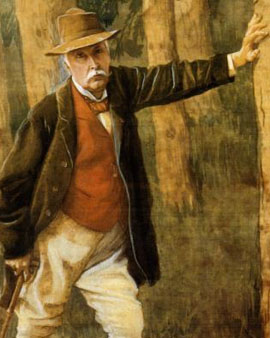James Tissot was particularly fond of Victorian England and religion. Among his most famous works are the Portrait of Miss Lloyd and The Ball. Born in Nantes, Jacques Tissot began his training as a painter in Paris at the age of 19. At the Academy of Fine Arts he studied with two important French artists of the 19th century - Hippolyte Flandrin and Jean-Auguste-Dominique Ingres, among others. His first exhibition was opened in 1859 at the Salon de Paris.
The final breakthrough as an artist came in 1861 when James Tissot bought his work Rencontre de Faust et de Marguerite and exhibited it at the Musée du Luxembourg. During his time in Paris, Tissot also met Édouard Manet and Edgar Degas. The latter painted one of Tissot's most famous portraits in 1867.
During the Franco-Prussian War, the artist was forced to flee to England. There he changed his name and made a name for himself as a genre and portrait painter. Furthermore, during this time he expanded his skills and learned the art of etching. He also worked as a caricaturist for the English magazine Vanity Fair. One of his most important works of this time is for example an Bildnis des Reichskanzlers Otto von Bismarck. In his late work Tissot increasingly turned to religious themes.
×





.jpg)
.jpg)
.jpg)
.jpg)
.jpg)
.jpg)
.jpg)
.jpg)
.jpg)
.jpg)
.jpg)
.jpg)
.jpg)
.jpg)
_-_(MeisterDrucke-69667).jpg)
_-_(MeisterDrucke-69667).jpg)
.jpg)
.jpg)
.jpg)
.jpg)
.jpg)
.jpg)
.jpg)
.jpg)
.jpg)
.jpg)
.jpg)
.jpg)
.jpg)
.jpg)
.jpg)
.jpg)
.jpg)
.jpg)
.jpg)
.jpg)
.jpg)
.jpg)
.jpg)
.jpg)
.jpg)
.jpg)
.jpg)
.jpg)
.jpg)
.jpg)
.jpg)
.jpg)
.jpg)
.jpg)
.jpg)
.jpg)
.jpg)
.jpg)
.jpg)
.jpg)
 c1883-85 - (MeisterDrucke-248871).jpg)
 c1883-85 - (MeisterDrucke-248871).jpg)
.jpg)
.jpg)
.jpg)
.jpg)
.jpg)
.jpg)
_-_-_(MeisterDrucke-928252).jpg)
_-_-_(MeisterDrucke-928252).jpg)
.jpg)
.jpg)
.jpg)
.jpg)
.jpg)
.jpg)
_(see_also_-_(MeisterDrucke-561464).jpg)
_(see_also_-_(MeisterDrucke-561464).jpg)
.jpg)
.jpg)
 c1865-68 - (MeisterDrucke-208833).jpg)
 c1865-68 - (MeisterDrucke-208833).jpg)
.jpg)
.jpg)
.jpg)
.jpg)
.jpg)
.jpg)
.jpg)
.jpg)
_-_(MeisterDrucke-1438528).jpg)
_-_(MeisterDrucke-1438528).jpg)
.jpg)
.jpg)
.jpg)
.jpg)
.jpg)
.jpg)
.jpg)
.jpg)
.jpg)
.jpg)
.jpg)
.jpg)
.jpg)
.jpg)
.jpg)
.jpg)
.jpg)
.jpg)
.jpg)
.jpg)
.jpg)
.jpg)
.jpg)
.jpg)
.jpg)
.jpg)
.jpg)
.jpg)
.jpg)
.jpg)
 c1881-2 (panel) - (MeisterDrucke-93406).jpg)
 c1881-2 (panel) - (MeisterDrucke-93406).jpg)
.jpg)
.jpg)
.jpg)
.jpg)
.jpg)
.jpg)
.jpg)
.jpg)
.jpg)
.jpg)
.jpg)
.jpg)
.jpg)
.jpg)
.jpg)
.jpg)
.jpg)
.jpg)
.jpg)
.jpg)
.jpg)
.jpg)
 - (MeisterDrucke-80785).jpg)
 - (MeisterDrucke-80785).jpg)
.jpg)
.jpg)
.jpg)
.jpg)
_-_(MeisterDrucke-1024176).jpg)
_-_(MeisterDrucke-1024176).jpg)
.jpg)
.jpg)
.jpg)
.jpg)
.jpg)
.jpg)
.jpg)
.jpg)
.jpg)
.jpg)
.jpg)
.jpg)
.jpg)
.jpg)
.jpg)
.jpg)
_-_(MeisterDrucke-1131382).jpg)
_-_(MeisterDrucke-1131382).jpg)
.jpg)
.jpg)
.jpg)
.jpg)
.jpg)
.jpg)
.jpg)
.jpg)
 c1879 (panel) - (MeisterDrucke-65043).jpg)
 c1879 (panel) - (MeisterDrucke-65043).jpg)
.jpg)
.jpg)
.jpg)
.jpg)
.jpg)
.jpg)
.jpg)
.jpg)
.jpg)
.jpg)
 1864 - (MeisterDrucke-89138).jpg)
 1864 - (MeisterDrucke-89138).jpg)
.jpg)
.jpg)
.jpg)
.jpg)
.jpg)
.jpg)
.jpg)
.jpg)
.jpg)
.jpg)






